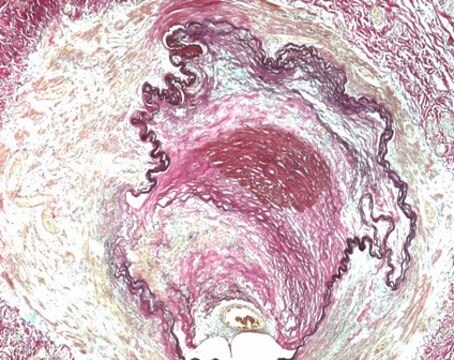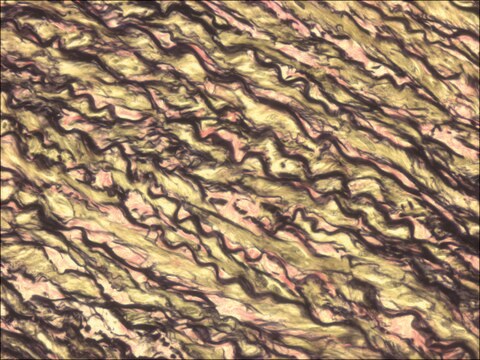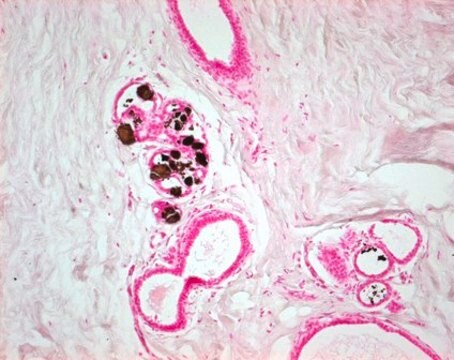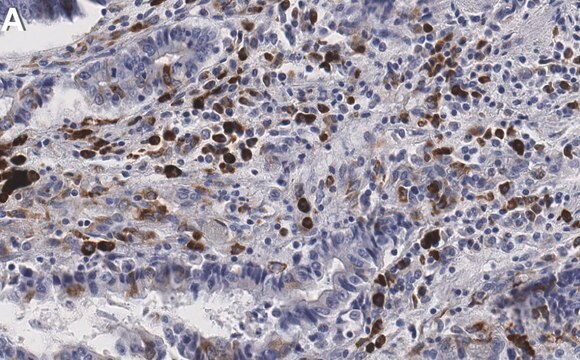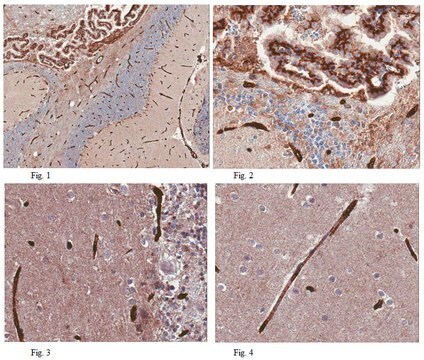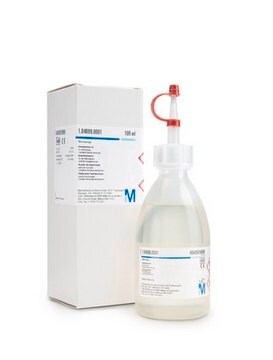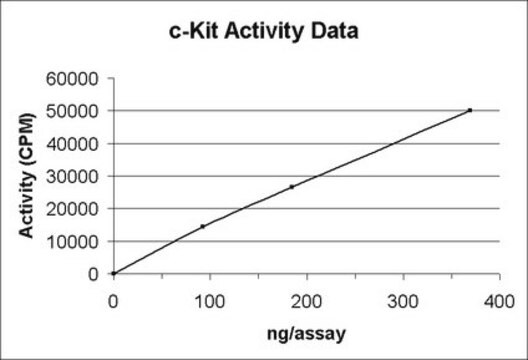17-10098
ChIPAb+ TATA Binding Protein (TBP) - ChIP Validated Antibody and Primer Set
ascites fluid, from mouse
别名:
TATA BINDING PROTEIN, TATA-box-binding protein, TATA-box factor, TATA-binding factor, TATA sequence-binding protein, Transcription initiation factor TFIID TBP subunit
登录查看公司和协议定价
所有图片(3)
About This Item
分類程式碼代碼:
12352203
eCl@ss:
32160702
NACRES:
NA.52
推荐产品
一般說明
All ChIPAb+ antibodies are individually validated for chromatin precipitation, every lot, every time. Each ChIPAb+ antibody set includes control primers (tested every lot by qPCR) to biologically validate your IP results in a locus-specific context. The qPCR protocol and primer sequences are provided, allowing researchers to validate ChIP protocols when using our antibody in their chromatin context. Each set also includes a negative control antibody to ensure specificity of the ChIP reaction.
The ChIPAb+ TATA Binding Protein (TBP) set includes the TATA Binding Protein (TBP) antibody, a negative control mouse ascites, and qPCR primers which amplify a 166 bp region of human GAPDH promoter. The TATA Binding Protein (TBP) and negative controls are supplied in a scalable "per ChIP" reaction size and can be used to functionally validate the precipitation of TATA Binding Protein (TBP)-associated chromatin.
The ChIPAb+ TATA Binding Protein (TBP) set includes the TATA Binding Protein (TBP) antibody, a negative control mouse ascites, and qPCR primers which amplify a 166 bp region of human GAPDH promoter. The TATA Binding Protein (TBP) and negative controls are supplied in a scalable "per ChIP" reaction size and can be used to functionally validate the precipitation of TATA Binding Protein (TBP)-associated chromatin.
TATA-box Binding Protein (TBP) is a general transcription factor that functions at the core of the DNA-binding multiprotein factor TFIID. Binding of TFIID to the TATA box is the initial transcriptional step of the pre-initiation complex (PIC). TBP plays a role in the activation of eukaryotic genes transcribed by RNA polymerase II and is a component of the transcription factor SL1/TIF-IB complex, which is involved in the assembly of the PIC (preinitiation complex) during RNA polymerase I-dependent transcription (Unitprot).
特異性
Reactivity with other species has not been confirmed.
Recognizes TATA Binding Protein (TBP).
免疫原
Full length recombinant human TBP.
應用
Chromatin Immunoprecipitation:
Sonicated chromatin prepared from HeLa cells (1 X 106 cell equivalents per IP) were subjected to chromatin immunoprecipitation using 2 µL of either Negative Ascites or 2 µL Anti-TATA Binding Protein (TBP) and the Magna ChIP® G Kit (Cat. # 17-611).
Successful immunoprecipitation of TBP associated DNA fragments was verified by qPCR using ChIP Primers, human GAPDH promoter as a positive locus, and GAPDH coding primers as a negative locus (Please see figures).
Data is presented as percent input of each IP sample relative to input chromatin for each amplicon and ChIP sample as indicated.
Please refer to the EZ-Magna ChIP G (Cat. # 17-409) or EZ-ChIP (Cat. # 17-371) protocol for experimental details.
Western Blot Analysis:
Representative lot data.
HeLa lysates were resolved by electrophoresis, transferred to PVDF membrane and probed with Anti-TATA Binding Protein (TBP) (1:1000 dilution).
Proteins were visualized using a secondary antibody conjugated to HRP and a chemiluminescence detection system (Please see figures).
Immunohistochemistry:
A 1:1,000-1:5,000 dilution of a previous lot was used in immunohistochemistry.
Immunocytochemistry:
A 1:1,000-1:5,000 dilution of a previous lot was used in immunocytochemistry.
Sonicated chromatin prepared from HeLa cells (1 X 106 cell equivalents per IP) were subjected to chromatin immunoprecipitation using 2 µL of either Negative Ascites or 2 µL Anti-TATA Binding Protein (TBP) and the Magna ChIP® G Kit (Cat. # 17-611).
Successful immunoprecipitation of TBP associated DNA fragments was verified by qPCR using ChIP Primers, human GAPDH promoter as a positive locus, and GAPDH coding primers as a negative locus (Please see figures).
Data is presented as percent input of each IP sample relative to input chromatin for each amplicon and ChIP sample as indicated.
Please refer to the EZ-Magna ChIP G (Cat. # 17-409) or EZ-ChIP (Cat. # 17-371) protocol for experimental details.
Western Blot Analysis:
Representative lot data.
HeLa lysates were resolved by electrophoresis, transferred to PVDF membrane and probed with Anti-TATA Binding Protein (TBP) (1:1000 dilution).
Proteins were visualized using a secondary antibody conjugated to HRP and a chemiluminescence detection system (Please see figures).
Immunohistochemistry:
A 1:1,000-1:5,000 dilution of a previous lot was used in immunohistochemistry.
Immunocytochemistry:
A 1:1,000-1:5,000 dilution of a previous lot was used in immunocytochemistry.
Research Category
Epigenetics & Nuclear Function
Epigenetics & Nuclear Function
Research Sub Category
Transcription Factors
Transcription Factors
The ChIPAb+ TATA Binding Protein (TBP) set includes the TATA Binding Protein (TBP) antibody, a negative control mouse ascites & qPCR primers which amplify a 166 bp region of human GAPDH promoter.
包裝
25 assays per set. Recommended use: ~2 μL of antibody per chromatin immunoprecipitation (dependent upon biological context).
品質
Chromatin Immunoprecipitation:
Sonicated chromatin prepared from HeLa cells (1 X 106 cell equivalents per IP) were subjected to chromatin immunoprecipitation using 2 µL of either Negative Ascites or 2 µL Anti-TATA Binding Protein (TBP) and the Magna ChIP® G Kit (Cat. # 17-611).
Successful immunoprecipitation of TATA Binding Protein (TBP)-associated DNA fragments was verified by qPCR using ChIP Primers, human GAPDH promoter (Please see figures).
Please refer to the EZ-Magna ChIP G (Cat. # 17-409) or EZ-ChIP (Cat. # 17-371) protocol for experimental details.
Sonicated chromatin prepared from HeLa cells (1 X 106 cell equivalents per IP) were subjected to chromatin immunoprecipitation using 2 µL of either Negative Ascites or 2 µL Anti-TATA Binding Protein (TBP) and the Magna ChIP® G Kit (Cat. # 17-611).
Successful immunoprecipitation of TATA Binding Protein (TBP)-associated DNA fragments was verified by qPCR using ChIP Primers, human GAPDH promoter (Please see figures).
Please refer to the EZ-Magna ChIP G (Cat. # 17-409) or EZ-ChIP (Cat. # 17-371) protocol for experimental details.
標靶描述
~42 kDa
外觀
Unpurified
Anti-TATA Binding Protein (TBP) (mouse monoclonal). One vial containing 50 μL ascites containing 0.05% sodium azide. Store at -20°C.
Negative Ascites (mouse). One vial containing 50 µL of mouse ascites with 0.05% sodium azide. Store at -20°C.
ChIP Primers, GAPDH promoter. One vial containing 75 μL of 5 μM each primer specific for human GAPDH. Store at -20°C.
FOR: TAC TAG CGG TTT TAC GGG CG
REV: TCG AAC AGG AGG AGC AGA GAG CGA
Negative Ascites (mouse). One vial containing 50 µL of mouse ascites with 0.05% sodium azide. Store at -20°C.
ChIP Primers, GAPDH promoter. One vial containing 75 μL of 5 μM each primer specific for human GAPDH. Store at -20°C.
FOR: TAC TAG CGG TTT TAC GGG CG
REV: TCG AAC AGG AGG AGC AGA GAG CGA
儲存和穩定性
Stable for 1 year at -20°C from date of receipt. Handling Recommendations: Upon first thaw, and prior to removing the cap, centrifuge the vial and gently mix the solution. Aliquot into microcentrifuge tubes and store at -20°C. Avoid repeated freeze/thaw cycles, which may damage IgG and affect product performance.
分析報告
Control
Includes negative control mouse ascites and primers specific for human GAPDH promoter.
Includes negative control mouse ascites and primers specific for human GAPDH promoter.
法律資訊
MAGNA CHIP is a registered trademark of Merck KGaA, Darmstadt, Germany
UPSTATE is a registered trademark of Merck KGaA, Darmstadt, Germany
免責聲明
Unless otherwise stated in our catalog or other company documentation accompanying the product(s), our products are intended for research use only and are not to be used for any other purpose, which includes but is not limited to, unauthorized commercial uses, in vitro diagnostic uses, ex vivo or in vivo therapeutic uses or any type of consumption or application to humans or animals.
儲存類別代碼
10 - Combustible liquids
我们的科学家团队拥有各种研究领域经验,包括生命科学、材料科学、化学合成、色谱、分析及许多其他领域.
联系技术服务部门